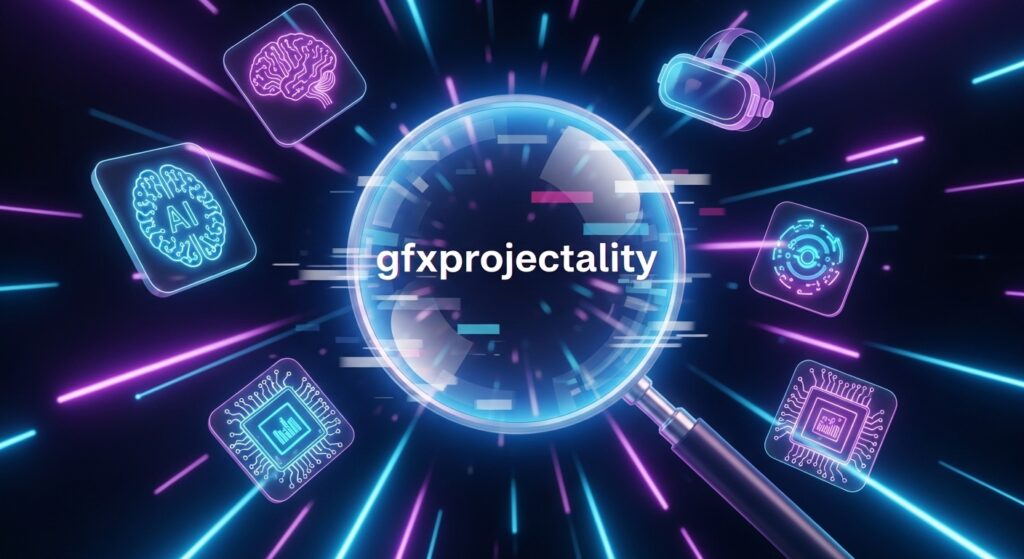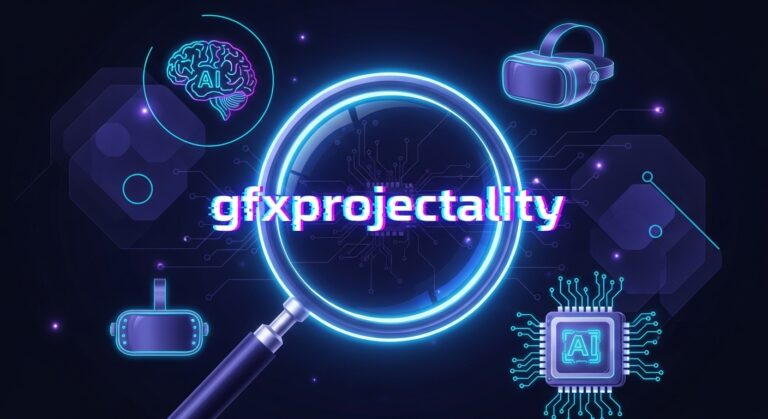We live in a world full of new tech ideas. Everyone talks about things like robots, virtual reality, and smart phones. But sometimes, you see a word that sounds cool but feels wrong. One word like that is “gfxprojectality.” You might find it in titles like “Tech Trends Gfxprojectality You Must Know!” It sounds like a big deal for the future. But is it real?
This article will tell you the truth. We’ll explain why “tech trends gfxprojectality” is a fake word made to trick people and search engines like Google. By the end, you’ll know how to spot fake words and focus on real tech news. We use very easy words so anyone can understand. No hard words, no confusion.
Tech moves fast, but not every fancy word is true. Let’s find out why.
What Is “Gfxprojectality”? Understanding the Word
Let’s look at this word: “gfxprojectality.” What does it mean?
The part “gfx” means “graphics.” You see it in video games or art programs. It’s about pictures and images on computers. That part is real and simple.
But “projectality”? That’s not a real word. I checked big dictionaries like Oxford and Merriam-Webster. It’s not there. It’s not in tech magazines or news from places like BBC or Wired either.
When you put them together, “gfxprojectality” sounds like a mix of “graphics” and “project.” They added extra letters to make it sound smart, like “projectile” or “reality.” But it’s fake. No one in tech uses it. No company makes a product called this.
Why make up a word? To get your attention. Online, strange words can show up high in Google searches. People click because it sounds new and exciting. But when you read it, there’s nothing real. This is a trick called a keyword trap.
How Fake Words Get Into Your News
How do these fake words spread? It’s because of search engines like Google. They use words to find and show websites. Good writers use real words like “new tech 2025.” But some people make up words to cheat the system.
Here’s how they do it in easy steps:
- They pick popular topics. Everyone searches for “new tech ideas.”
- They add a fake word like “gfxprojectality” to sound special. Not many people search it, so it’s easy to rank high.
- They make cheap websites with little content. These copy real articles but use the fake word a lot.
- They share links on social media. On places like X or Facebook, they use tags like #Gfxprojectality to look cool.
I searched “tech trends gfxprojectality” and found bad websites. One called Blogbuzz News had a post from August 2025. It talked about graphics and working from home but kept repeating the fake word. It had no real facts. Other links didn’t work or went to empty pages. This shows it’s not from real experts. It’s just a trick.
Good tech news comes from places like TechCrunch or MIT Technology Review. They don’t use fake words because people trust them.
Why Fake Words Are Bad for You
Clicking on these tricks can cause problems. Here’s why.
First, they spread wrong information. Fake articles mix some true things with lies. You might read about “green graphics,” which is real. But when it’s tied to a fake word like “gfxprojectality,” it confuses you. Later, you might not trust real news.
Second, they can lead to scams. Some trick websites show ads for fake classes, like “Learn Gfxprojectality for $99!” You pay and get nothing. Or worse, they give you “free tools” that are really viruses for your computer.
Third, you waste time. Life is busy, and you want good information. Fake articles are a waste. People spend hours reading junk online every week. You could use that time to learn real things, like how AI is growing.
For businesses, it’s even worse. If you make graphics and follow “gfxprojectality” trends, you might buy the wrong tools. That wastes money. It’s better to use trusted tools like Adobe or Unity.
Kids and new learners get hurt too. They might think “gfxprojectality” is a real tech word. This teaches them wrong things. It’s better to learn simple, real ideas first.
Fake words help no one. Knowing about them keeps you safe.
Real Tech Trends in Graphics You Should Know
Let’s forget the fake stuff. Graphics tech is exciting, and you don’t need made-up words. Here are five real trends for 2025 and beyond. These come from experts at big events like SIGGRAPH and reports from Gartner.
Trend 1: AI Helps Make Pictures
Artificial intelligence (AI) is changing how we make images. Tools like Midjourney or DALL-E let you type “a dog in a spaceship” and get a picture fast. You don’t need to draw.
Why it’s cool: It saves time for artists. In movies, it makes special effects faster. But we must be careful not to copy other artists’ work.
Real example: Disney uses AI to plan movie scenes. It’s happening now.
Trend 2: Super Smooth Games and Virtual Reality
Video games look better than ever. A trick called ray tracing makes light in games look real, like it bounces naturally. NVIDIA’s RTX cards do this.
In virtual reality (VR), this means no delays. You feel like you’re really there. Oculus Quest is making this better.
Fun fact: The game Cyberpunk 2077 had problems when it started but fixed them with this tech. Now people love it.
Trend 3: Green Graphics That Save Energy
Tech can hurt the environment. Graphics cards use a lot of power. Now, there’s a trend to make them better for the planet.
Companies like AMD make chips that use less energy. New software also helps save power.
Why it matters: Graphics use 10% of the energy in big computer centers. Saving energy helps the Earth and saves money.
Trend 4: Working Together Online
Many people work from home now. Tools like Figma and Canva let teams draw and edit pictures together online.
No more sending emails back and forth. You see changes right away. This is great for teams all over the world.
Fact: Since the pandemic, these tools grew 300%, says Zoom.
Trend 5: Augmented Reality in Daily Life
Augmented reality (AR) puts digital pictures in the real world. Think of Pokemon Go, but better.
For example, IKEA’s app shows how a couch looks in your room. Graphics make it look real.
In the future, schools might use AR to show history with 3D models.
These trends are real and backed by facts. No fake words here.
How to Spot Fake Tech Words: Easy Tips

How do you stay safe from fake words? Follow these simple tips:
- Check where it’s from: Is the article from CNN or Forbes? Trust it. From a random blog? Be careful.
- Look for meanings: Real words have clear explanations. Check Wikipedia or dictionaries.
- See if experts talk about it: Do people on LinkedIn mention it? If not, it’s probably fake.
- Ask if it makes sense: Does the word solve a real problem, or is it just exciting talk?
- Read what others say: Do users give real details, or just say it’s great? Empty talk is a warning.
Use these tips. If you see a word like “superflux tech,” stop and check.
Why People Make Fake Words
Not everyone who makes fake words is bad. Some do it to get noticed. A small blog needs clicks to make money. One popular post can pay their bills.
Others follow bad advice. Some online guides say, “Use long, unique words to rank better.” So they make up words without thinking.
Big companies don’t do this much. They focus on real products, not tricks.
But fake words hurt everyone. They make it hard to trust news. When fake stuff fills your screen, good information gets lost.
You can help. Share good articles. Tell people about fake ones.
Fixing Tech News for Everyone
Search engines are trying to stop this. Google’s updates, like Helpful Content, reward good websites and push fake ones down.
But you can help too. Tell search engines about bad sites. Use ad blockers on weird pages.
Talking to others helps. Places like Reddit’s r/technology share real tech news. Join those groups.
In 2025, AI makes it easier to create fake words. But if you’re smart, you can stay ahead.
Conclusion: Stick to Real Tech, Skip the Tricks
“Tech trends gfxprojectality” is not real. It’s a fake word made to get clicks. We showed it’s made up, risky, and not needed.
Real trends like AI pictures and green tech are way more exciting. They make a difference.
Disclaimer: This article is only for sharing information. It is not an ad. We do not make money from any links or products. We try to give correct facts, but we are not responsible if something goes wrong. Always check things yourself before you trust new tech words or sites.
Explore More
- Is ‘AgentCarrot ATX Bogus’ a Misleading Keyword? Uncovering the Truth
- Exposing the Fake ‘Fishing ThunderOnTheGulf’: How to Spot Misleading Online Keywords
- Unmasking ‘Social Media Stuff Embedtree’: A Misleading Keyword You Shouldn’t Trust

Ramona P. Woodmansee is a writer who helps people stay safe on the internet. She writes about tricky apps and online scams in a simple and honest way. Her stories help readers make smart choices online. Ramona’s articles are on trusted websites about internet safety. People trust her because she writes clearly and truthfully.





